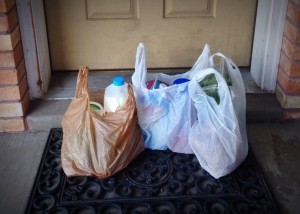Technology is bringing groceries right to the front door. In the past ten years the amount spent on ordering groceries online in the United States has risen from $545 million to $6.5 billion, according to a report from grocery website peapod.com. The website served a total of 72 zip codes in 1994. Now, in 2014, it serves 2,531 zip codes.

Among the most commonly used grocery websites are netgrocer.com, peapod.com and mybrands.com. These sites provide a full range of groceries, from produce to frozen foods. Other grocery sites, along with familiar stores such as Walmart and Smiths, only offer non-perishable items for home delivery.
Online grocery companies are shifting their attention from the computer to mobile grocery shopping.
Peapod.com CEO Andrew Parkinson explained why mobile technology is significant in today’s society. “A large segment of our customers is time-starved, tech-savvy Millennial moms — always on the go, never without their smartphones,” Parkinson said. “Our aim is to bring convenience to their lives, and we recognized early on that that means putting mobile first.”
While many moms are making the shift to online/mobile grocery shopping, college students are also picking up on the trend.
Stacy Mitchell, a senior, prefers online grocery shopping for its mobile method. “I rarely have time to go grocery shopping, and before I know it I’m out of groceries,” she said. “Online grocery shopping is quick and simple. I can order them from anywhere if I have Internet.”
BYU senior Kylie Lewis saves time by planning ahead through online grocery shopping. “I have my groceries delivered every couple weeks, and I plan ahead so I don’t have to worry about running out as often,” Lewis said.
Netgrocer.com, peapod.com and mybrands.com offer coupons and sales often, creating a way to save money while shopping online for groceries. Lewis saves money through this method. “Not only do I take advantage of the sales, but I also don’t buy excess groceries like I normally would at a local grocery store,” Lewis said.
The product prices are comparable to local grocery stores, and a small delivery fee is attached to the order, which varies with zip code.
Online grocery websites carry almost all of the groceries and brands an average grocery store does. Even special dietary products, such as gluten-free or organic products, are well represented. Netgrocer.com and peapod.com both have specific sections on their websites for natural and organic foods.




